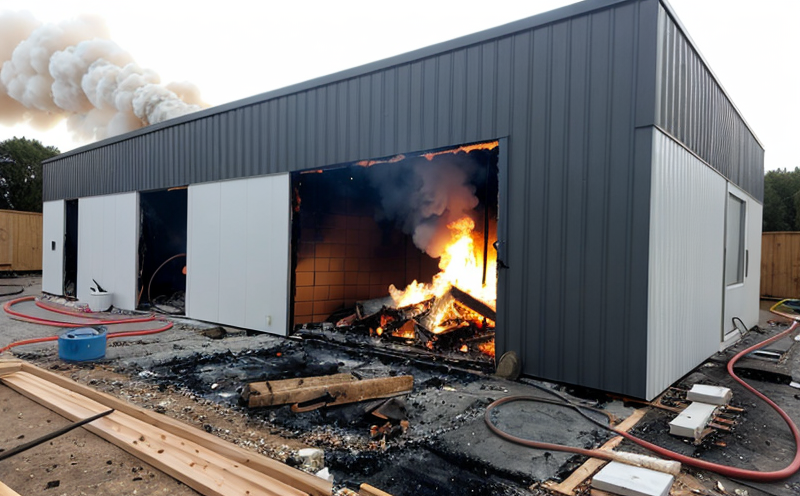Fire Performance Assessment of Spray Foam Insulation
The fire performance assessment of spray foam insulation is a critical step in ensuring that building materials meet stringent fire safety standards. In this process, we evaluate the ability of spray foam insulation to resist ignition and spread of flame under controlled conditions. This service targets sectors such as construction, architecture, and engineering where compliance with international standards like ISO 9702 or ASTM E84 is essential.
The assessment involves testing how effectively the spray foam can prevent the spread of fire within a building structure. The test parameters include the time it takes for flames to reach the other side of the specimen, the rate at which heat is transferred through the material, and the ability of the insulation to resist flaming and glowing after the ignition source is removed.
The process begins with careful preparation of the spray foam specimen. This includes ensuring that the sample is representative of real-world conditions, taking into account factors such as density, moisture content, and application method. Once prepared, the specimen undergoes rigorous testing in a controlled environment where it is exposed to an ignition source.
The testing apparatus used for this assessment typically involves a tunnel furnace or parallel-bar apparatus designed according to relevant standards. The specimen is placed between two metal plates that are separated by a specific distance as per ASTM E84 guidelines. The apparatus ensures consistent and repeatable results, providing reliable data on the fire performance of spray foam.
The testing process is conducted under strict conditions to simulate real-world scenarios. For instance, the temperature and humidity levels in the laboratory environment closely mimic those found at construction sites or in buildings where this insulation is commonly used. This ensures that the test results accurately reflect how the material will perform in actual use.
After exposure to the ignition source, detailed observations are made on various parameters including flame spread index (FSI) and smoke developed index (SDI). These indices provide valuable insights into the fire resistance of the spray foam insulation. The FSI measures the relative rate at which flames spread across the surface of the specimen, while SDI assesses the amount of smoke produced during the test.
The results are then analyzed against specified criteria to determine if the spray foam meets the required standards for fire performance. Compliance with these standards is crucial not only for meeting regulatory requirements but also for ensuring the safety and integrity of buildings and structures.
Our laboratory adheres strictly to international standards such as ISO 9702 and ASTM E84, which provide detailed protocols for conducting these assessments. These guidelines ensure that every aspect of the testing process—from specimen preparation to data interpretation—is conducted in a standardized manner. This consistency is vital for producing reliable and repeatable results.
Scope and Methodology
| Parameter | Description |
|---|---|
| Ignition Source | Aerosol flame source with a specified heat release rate. |
| Spray Foam Specimen Preparation | Standard dimensions and density as per ASTM E84 guidelines. |
| Tunnel Furnace Setup | Specific temperature, humidity, and airflow conditions. |
| Data Collection | Flame spread index (FSI) and smoke developed index (SDI). |
The scope of our fire performance assessment service encompasses a comprehensive evaluation of the spray foam insulation's ability to resist ignition and prevent flame spread. This includes not only laboratory testing but also consultation on material selection, application techniques, and compliance with relevant standards.
Benefits
- Ensures compliance with international fire safety regulations (ISO 9702, ASTM E84).
- Provides valuable data for improving product performance and reliability.
- Reduces the risk of non-compliance penalties and legal issues.
- Safeguards building integrity and occupant safety in case of a fire event.
- Supports R&D initiatives by identifying areas for material improvement.
- Enhances reputation through adherence to high-quality standards.
- Achieves cost savings by avoiding retesting due to non-compliance issues.
The benefits extend beyond mere compliance; they also contribute to the overall safety and quality of buildings, ensuring that spray foam insulation performs optimally under fire conditions. This service is an indispensable tool for construction professionals aiming to meet stringent fire safety standards while delivering high-quality products.
Why Choose This Test
Selecting this test for your spray foam insulation is a strategic decision that ensures comprehensive evaluation and compliance with international standards. Here are several reasons why choosing our service is advantageous:
- Comprehensive Evaluation: Our tests cover all critical aspects of fire performance, including flame spread index (FSI) and smoke developed index (SDI).
- Standardized Processes: We adhere strictly to international standards such as ISO 9702 and ASTM E84, ensuring reliability and consistency.
- Rigorous Testing Environment: Our laboratory mimics real-world conditions, providing accurate and representative test results.
- Expert Consultation: Our team of experts can provide valuable insights into material selection, application methods, and compliance strategies.
- Cost-Effective Solutions: By ensuring initial compliance, we help you avoid costly retesting and potential penalties.
- Safety Assurance: Ensuring that spray foam insulation meets fire safety standards contributes to the overall safety of buildings and occupants.
In conclusion, choosing our fire performance assessment service for your spray foam insulation is a proactive step towards ensuring compliance with international standards and enhancing building safety. Our expertise and commitment to quality make us the trusted partner for this critical evaluation process.





